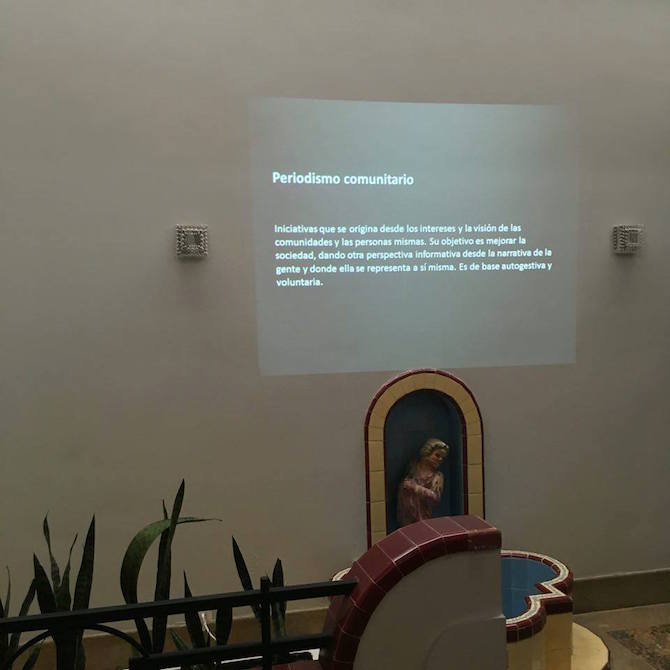Search
To search for an exact match, type the word or phrase you want in quotation marks.
A*DESK has been offering since 2002 contents about criticism and contemporary art. A*DESK has become consolidated thanks to all those who have believed in the project, all those who have followed us, debating, participating and collaborating. Many people have collaborated with A*DESK, and continue to do so. Their efforts, knowledge and belief in the project are what make it grow internationally. At A*DESK we have also generated work for over one hundred professionals in culture, from small collaborations with reviews and classes, to more prolonged and intense collaborations.
At A*DESK we believe in the need for free and universal access to culture and knowledge. We want to carry on being independent, remaining open to more ideas and opinions. If you believe in A*DESK, we need your backing to be able to continue. You can now participate in the project by supporting it. You can choose how much you want to contribute to the project.
You can decide how much you want to bring to the project.

Nowadays the world’s so awash with self-love that we all hear said as the first commentary on anything “I like – I don’t like” in a short lapse of time immediately after coming across the thing in question. This occurs particularly on social networks, in which there is no respite, curiosity, or questioning. There is only I like – I don’t like, returning to trivial chitchat, while chatting to maintain one’s finger on the pulse and circulate the latest jokes. But, repeatedly hearing this duo in the last cultural or art events I have attended, worried me. Particularly on seeing people who are supposed to have a vision of the world that goes beyond appearances. What happens then? Mistrust or fact?
It’s nothing new. Plato talked of an eternal essence of beauty, Kant of a universal faculty for aesthetic judgement, Bourdieu of the social sense of taste. Now, what happens if in the 21st century this duo is situated on the same line as the famous saying, hunger joined a craving to eat?
I’ll explain myself by taking various deviations. The first deviation goes from the specific to the universal, taking a particular situation to try and elucidate to what this global attitude of I like –I don’t like corresponds. The specific context is a historical documentary show with pedagogical aims that sought to bring to the public four years of investigative journalism carried out by a digital editorial in Guatamela called Prensa Comunitaria. The contents of said show touched on subjects such as community protests, demonstrations in squares in different cities of the country; the testimonies of political prisoners; persecutions and illegal detentions; assassinations, ecocide, and reencounters and acts of communitarian solidarity. Using different visual media (anti-postcards, drawings, notebooks, maps, glossary, video, photographs, wallpaper, sound, recreation of spaces and installation) and appropriating all the rooms of a house, this activity showed all that information that the media endeavour not to let reach the capital of the country or give the appearance of criminalizing pacific demonstrations in defence of life. It’s worth adding an important piece of information: Guatemala is a centralised country and those of us who live in the capital arrogantly believe that what happens beyond this derisory bit of territory doesn’t exist, it’s not true, or is the fruit of the “brainwashing” of foreign NGOs.
In the conceiving of said show there were calculated gestures such as avoiding the use of certain words in the visual communication of it. Works such as show and exhibition, art or artistic, were omitted for being charged with so much meaning that to have used them would have driven to the automatism of comparing said activity with the traditional exhibition format that in the majority of times, is reduced to the ambit of the art market. In Guatemala, at least, where there are many commercial contemporary art galleries but not even one museum or specialised library, nor centres for documentation or careers that offer a good training. For this, the site where the show took place is also an important detail. An independent art space that is just starting up, directed at the idea of stimulating research and training in contemporary art. A space where pedagogy is placed at the forefront. Always the ugly duckling of the art scene, always an area seen as “useful” only to a child-youth or very ignorant public, or the other is the typical “ it’s for-communists” (yes, in Guatemala this hackneyed prejudice still dominates) or for hippies. For it seems, that in a country where 60% of the population is indigenous and talks 25 languages, not tongues nor dialects, subjects related to the indigenous communities and the defence of natural resources are not as relevant as going to the opening of an exhibition.
In short, Guatemala en MovimientoS, the name given by Prensa Comunitaria to this historical-documentary show, is about bringing to public attention details, circumstances and nuances to contributing to a limitation of the lack of interest, apathy even, with which many assume these subjects. For the public it’s about making an effort to go beyond ideologies and apprehend realities that merit not disappearing into air. It’s a show that requires time to see, read, think and question. In short, to put a handbrake on the speed with which news passes by on television and social networks degrading significant events to the level of offers of the day. Simply by making this pause, we reiterate that there will always be a remnant of subjectivity that can’t be appropriated by the discourses.
What was the reaction of the art brethren, of the local scene? Well, not arriving or saying: “art doesn’t change anything”, “art will always be elitist”, “why ask art to change anything?” and of course, the “I understand but I don’t like it”. The pure repetition of empty words and this along with the random fact that this activity took place in parallel with the 20 Biennale de Arte Paiz (Guatemala) the subject of which in this edition was by chance Ordinary/Extraordinary: The democratisation of art or the desire to change things..

Second deviation. The Purloined Letter [[The Purloined Letter first published in December 1844 in The Gift. Later reproduced in numerous journals and magazines. ]], a detective story by Edgar Allan Poe that revolves around the question, what does the letter bring other than its content? For the subject that concerns us the relevance is in the figure of the police Prefect who fails to find the stolen letter: What is all this boring, and probing, and sounding, and scrutinizing with the microscope and dividing the surface of the building into registered square inches—what is it all but an exaggeration of the application of the one principle or set of principles of search, which are based upon the one set of notions regarding human ingenuity, to which the Prefect, in the long routine of his duty, has been accustomed? (….).You will now understand what I meant in suggesting that, had the purloined letter been hidden any where within the limits of the Prefect’s examination—in other words, had the principle of its concealment been comprehended within the principles of the Prefect—its discovery would have been a matter altogether beyond question.
It sounds somewhat familiar: art professionals more immersed in paying homage to their own personal identity, the cult to be yourself, of self-realization, self-esteem and of course, instant satisfaction. “Cool, adaptable” individuals, “lovers of pleasure and liberties, (…) all at once” (Lipovetzky, Los tiempos hipermodernos, 2006) tinted with fluidity and flexibility, in which the belief systems are interchangeable and subject to best-selling fashion. Supposedly more receptive to criticism, more open to difference, to trying, debating, owners and masters of their lives without any deep ties.
What’s dire about that personal identity? That the line between being open to new forms of knowledge and the principle of self-service (the search for emotions and pleasures here and now, deprived of a sense of transcendence and an interest in practical utility) is so thin that without even realising it, art advances to the drift of hunger joined a craving to eat. In a few words, what transcends responds to the quantity of satisfaction that it brings to the skin of the eye [2]. A result of the pollution of our current time that has managed that through the art market the gaze is placed on the imaginary of the form and/or in works to the service of bodies that are for nothing more than the substance of pleasure. It is the formulation of a new cogito: I see, therefore I enjoy. Putting the accent on the ‘I’, the eye (not the gaze) and the satisfaction derived from the scopic drive.
It’s just what Byun-Chul Han describes in his book The Transparency Society (2013). Images turn transparent when they are “liberated from all dramaturgy, choreography and scenography, liberated of any hermeneutic depth, even from meaning and thus become pornographic”. Defining the pornographic as the “immediate contact between image and eye” that converts every subject into its “own object of publicity”. The subject, imprisoned in the repetition of a series of principles, not unlike the Prefect of the police who fails to find the letter, simply becomes trapped in the illusionary character of the fixation of meaning. Whereby the failure of its imaginary, symbolic construction is left out in the open, the subject, in defence of its id, appeals to “I don’t like” to dissimulate. The result is a loathing of the void that in principle signifies a horror of desire.

Paulina, from Guatemala, has abandoned the four walls of her consultancy and likes to think also the bad habit of distancing oneself from life, on the never-ending carousel of concepts and theories. But she didn’t leave with her hands empty, in her pocket she carries the desire to rescue the value of the unique, heritage of her training in psychoanalysis. She hopes to do something with this. She hopes to be able to engage with the unforeseen aspects of reality. To document them and let them be seen with a twist of imagination. With luck they will stop going unnoticed and perturb like that strand of hair in the soup.
"A desk is a dangerous place from which to watch the world" (John Le Carré)